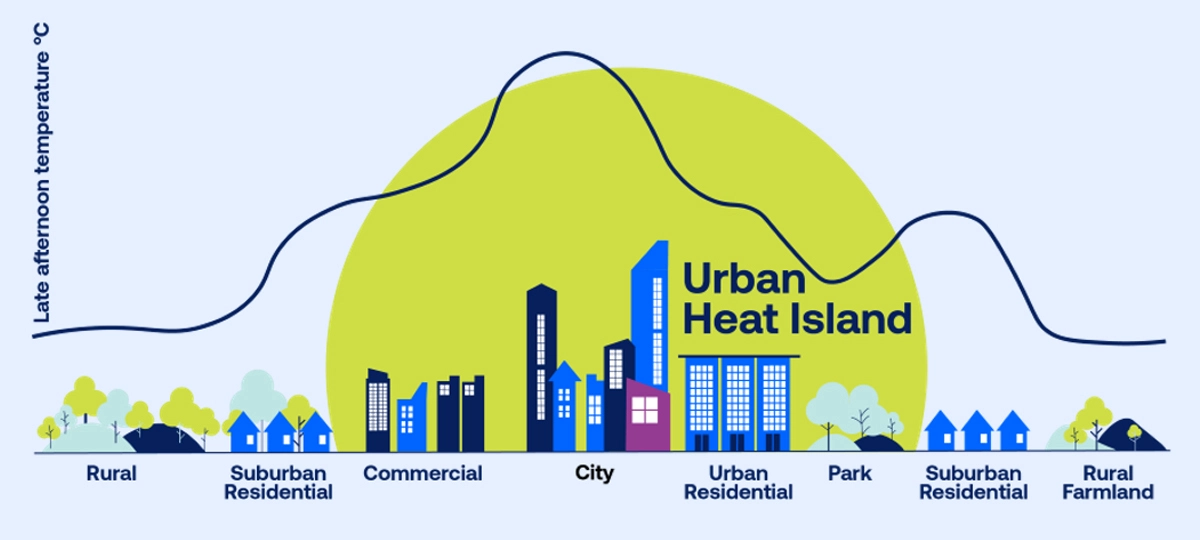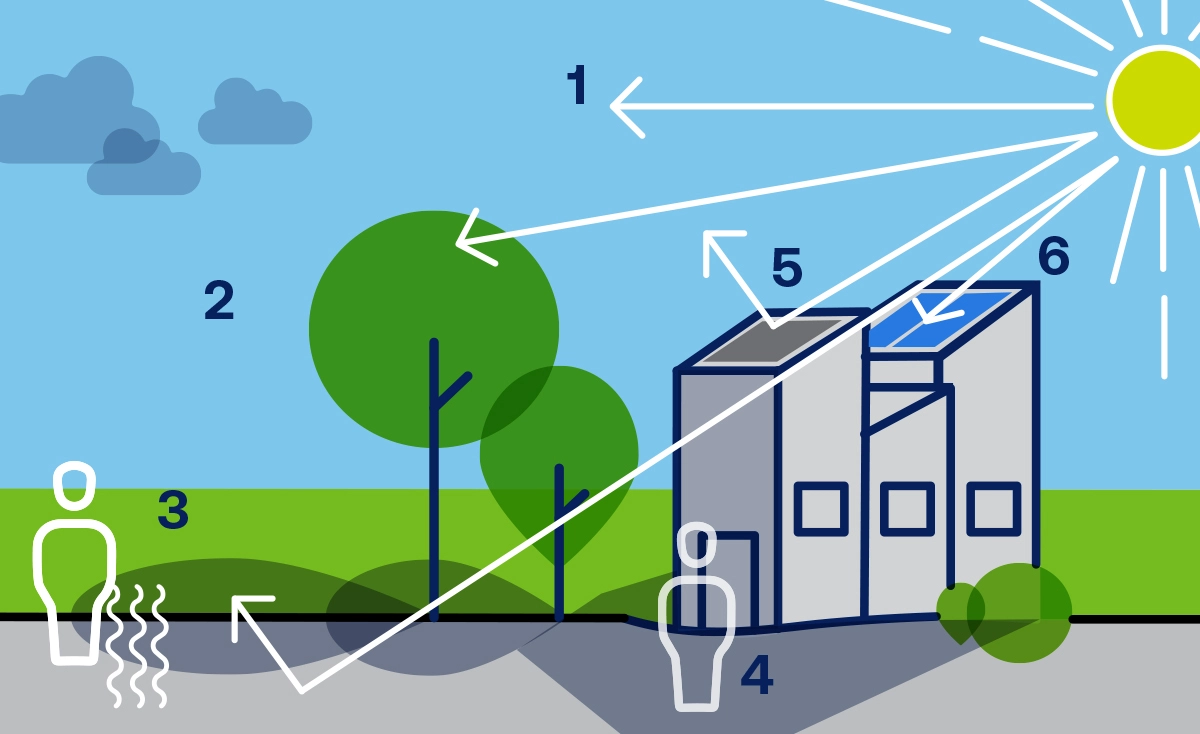Smart Surfaces and Lung Health
See how light-colored, reflective and green surfaces can combat extreme heat and create cooler, more livable communities.Communities across the U.S. regularly experience extreme heat, floods and other disasters each year due to climate change. The American Lung Association is working on practical solutions like Smart Surfaces to address the impacts of climate change and improve the health of people across America.
The Problem: Extreme Heat in Cities
Two-thirds of the average U.S. city is made up of roads, parking spaces, sidewalks and roofs. Because these surfaces are typically dark and non-porous, they contribute to urban heat, flooding, increased air pollution and poor health.
Cities Become Heat Islands
Structures such as buildings, roads, and parking lots absorb the sun’s heat. Urban areas become "islands" of higher temperatures because they tend to have higher concentrations of these heat-absorbing structures and fewer trees and bodies of water. These "heat islands" experience higher temperatures than outlying areas. Daytime temperatures in urban areas are about 1-7°F higher than temperatures in outlying areas and nighttime temperatures are about 2-5°F higher.
Causes of urban heat islands include dark non-porous (impermeable) surfaces (roads, parking lots, and roofs), reduced natural landscapes like trees and grass, heat generated from human activity, weather, and geography.
Excessive Heat Impacts Health
Urban Heat Is a Health Equity Issue
Black, Indigenous, and people of color are more likely to be living in areas most impacted by urban heat and poor air quality. This is due to a history of discriminatory practices that consists of systematic denial of services such as mortgages, insurance loans, and other financial services to residents of certain areas based on their race or ethnicity and other means of limited political power within these communities. This history of disinvestment and redlining is linked to increased vulnerability of communities of color and those living under the federal poverty line to urban heat and ground-level ozone.
Several factors make urban heat a health equity issue:
The Solution: Smart Surfaces to Reduce Heat in Cities
Smart Surfaces encompass a suite of cutting-edge technologies, including reflective (cool) roofs and pavements, green roofs, trees, solar photovoltaics (PV) and rain gardens. Designed to mitigate urban heat, enhance air quality and improve health, the addition of these transformative urban features can make cities more resilient and vibrant. Smart Surfaces can cool cities by 5°F, deliver large reductions in flooding and provide economic benefits to cities.
There Are Many Types of Smart Surfaces
Below explains different kinds of Smart Surfaces and the benefits they provide over conventional surfaces.
Greenspaces Can Improve Health
Ozone levels are highest in cities in part because of the increased temperatures from heat absorbed by roads and roofs. Incorporating trees, green roofs and parks in urban settings can reduce temperatures and improve health.
Here are just a few benefits of greenspaces:
Combining Smart Surfaces Increases Impact
For example, a green roof + solar panels can generate clean energy, reduce building energy use, manage storm water runoff, and filter air pollutants.
When smart surfaces are combined:
- Overall temperature feels ~15-20⁰F cooler.
- Ambient air temperature is ~5-10⁰F cooler
- Reduced heat radiance from more reflective surfaces—feels ~5⁰F cooler. Less of sun’s energy is absorbed and radiated as heat.
- Shade feels ~10⁰F cooler.
- Cool roof reflects sunlight, reducing building energy use and reducing radiation of sunlight as heat into city air.
- Solar PV reduces reliance on polluting power plants and shades buildings. Less smog and better air quality—feels ~1-3⁰F cooler.
Policymakers and individuals can make our communities more livable, reduce heat and air pollution, and improve our lung health with smart surface choices.
How to talk to your elected and appointed officials about Smart Surfaces to reduce excessive heat.




 Light colored roads reflect more sunlight than dark asphalt. This leads to reduced pavement temperature, cooler streets and neighborhoods, and greater pedestrian and resident comfort. Light colored, cool roads increase pavement lifespan, reduce street lighting requirements while providing greater visibility resulting in fewer car accidents.
Light colored roads reflect more sunlight than dark asphalt. This leads to reduced pavement temperature, cooler streets and neighborhoods, and greater pedestrian and resident comfort. Light colored, cool roads increase pavement lifespan, reduce street lighting requirements while providing greater visibility resulting in fewer car accidents.  Concrete is responsible for 8% of global carbon emissions. New concrete materials are available that make it carbon neutral or even carbon negative.
Concrete is responsible for 8% of global carbon emissions. New concrete materials are available that make it carbon neutral or even carbon negative.  Porous pavements allow rain to absorb into the ground, reducing pollution, stormwater runoff, and flood risk. Porous pavements can lower temperatures through evaporative cooling. Porous pavements act as a filter for water, being cleaned as it passes through the soil into groundwater. Porous pavements decrease the likelihood of stormwater overflowing into sewers and bodies of water. Types of porous pavements include porous asphalt, concrete, permeable pavers, and porous grid pavers with turf or gravel.
Porous pavements allow rain to absorb into the ground, reducing pollution, stormwater runoff, and flood risk. Porous pavements can lower temperatures through evaporative cooling. Porous pavements act as a filter for water, being cleaned as it passes through the soil into groundwater. Porous pavements decrease the likelihood of stormwater overflowing into sewers and bodies of water. Types of porous pavements include porous asphalt, concrete, permeable pavers, and porous grid pavers with turf or gravel.  Solar photovoltaic cells, also called Solar PV, converts sunlight into renewable energy, helping cities reduce their reliance on fossil fuels. Solar reduces energy demand from non-renewable power plants, reducing greenhouse gas emissions, and improving air quality. Solar panels also provide shade for buildings, sidewalks, and other public areas.
Solar photovoltaic cells, also called Solar PV, converts sunlight into renewable energy, helping cities reduce their reliance on fossil fuels. Solar reduces energy demand from non-renewable power plants, reducing greenhouse gas emissions, and improving air quality. Solar panels also provide shade for buildings, sidewalks, and other public areas. Green roofs are living, breathing entities that absorb rainwater, reduce heat absorption, and improve air quality. Green roofs cool buildings, reduce storm water runoff, and provide urban wildlife habitats. With green and light-colored roofs, less heat is transferred into buildings and into the city air. Cool roofs reduce energy consumption and costs. The plants on a green roof reduce carbon dioxide, nitrogen dioxide, and particulate matter in the air. Another benefit of a green roof is that they have longer effective life spans than traditional dark and impervious roofs.
Green roofs are living, breathing entities that absorb rainwater, reduce heat absorption, and improve air quality. Green roofs cool buildings, reduce storm water runoff, and provide urban wildlife habitats. With green and light-colored roofs, less heat is transferred into buildings and into the city air. Cool roofs reduce energy consumption and costs. The plants on a green roof reduce carbon dioxide, nitrogen dioxide, and particulate matter in the air. Another benefit of a green roof is that they have longer effective life spans than traditional dark and impervious roofs. Urban greening is the practice of planting trees, shrubs, and native grasses throughout the city, including parking lots, along streets, and in vacant lots. Urban trees provide shade which reduces temperature at the street level. Urban trees and greenscapes can reduce the temperature by up to 7°F during the day and 22°F at night. Greenscapes turn carbon dioxide into oxygen, remove pollutants from the air, and reduce flood risk. Urban greenscapes also reduce water pollution caused by runoff during heavy rains. Trees reduce the flood risk because trees absorb water during heavy rains.
Urban greening is the practice of planting trees, shrubs, and native grasses throughout the city, including parking lots, along streets, and in vacant lots. Urban trees provide shade which reduces temperature at the street level. Urban trees and greenscapes can reduce the temperature by up to 7°F during the day and 22°F at night. Greenscapes turn carbon dioxide into oxygen, remove pollutants from the air, and reduce flood risk. Urban greenscapes also reduce water pollution caused by runoff during heavy rains. Trees reduce the flood risk because trees absorb water during heavy rains.  Rain gardens and bioswales both collect rainwater runoff, filter stormwater pollutants from the water, and allow water to be reabsorbed into the soil. Bioswales are similar to rain gardens but are much larger and can capture more runoff from larger surfaces like streets and parking lots. Rain gardens and bioswales assist in cooling the air temperature and provide a habitat for native plants and wildlife.
Rain gardens and bioswales both collect rainwater runoff, filter stormwater pollutants from the water, and allow water to be reabsorbed into the soil. Bioswales are similar to rain gardens but are much larger and can capture more runoff from larger surfaces like streets and parking lots. Rain gardens and bioswales assist in cooling the air temperature and provide a habitat for native plants and wildlife. 
